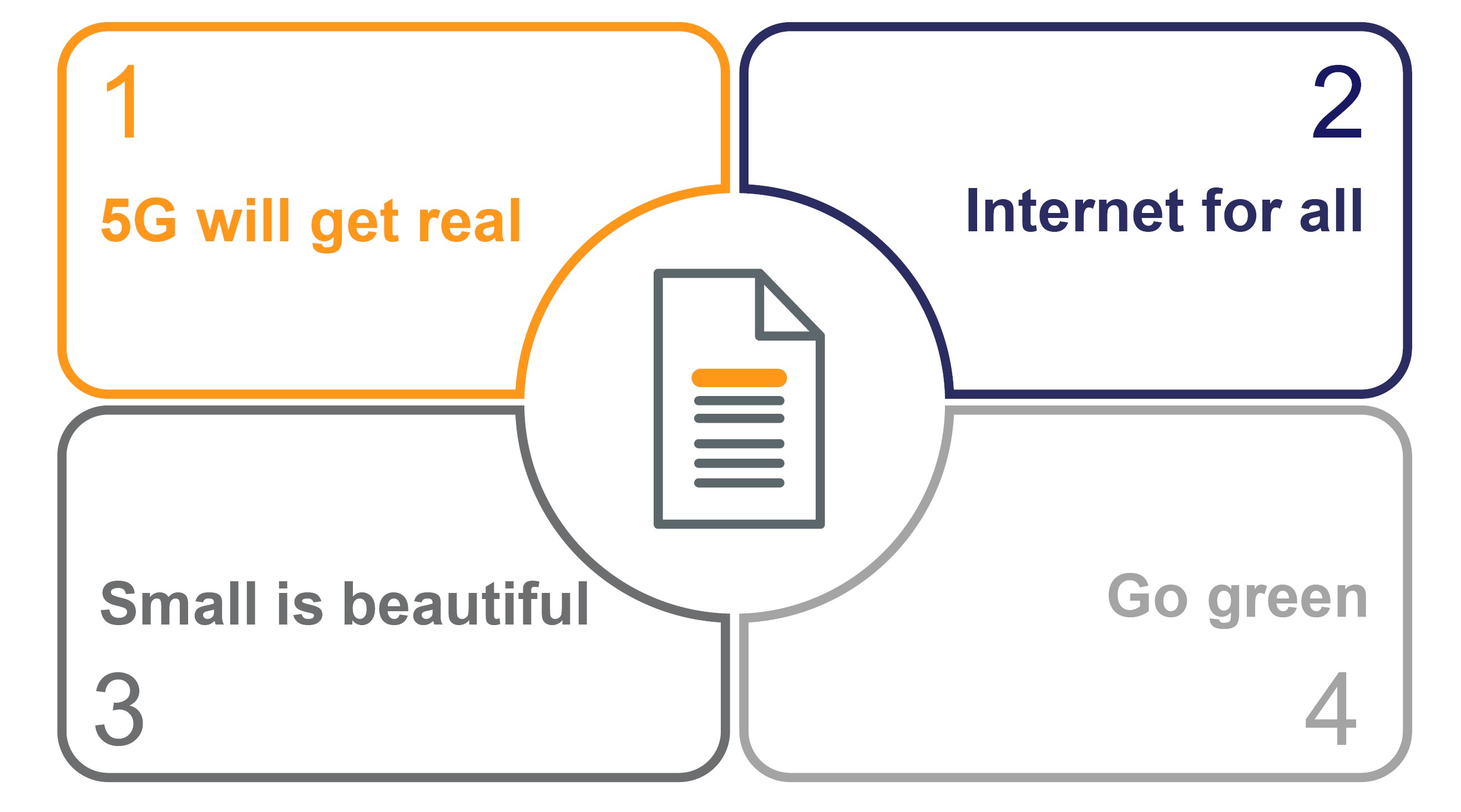Megatrends for 2022 and what they mean for bills
2 February 2022
|
Katarina Radman
In 2022, four key megatrends will present both opportunities and challenges to the telecoms industry. Katarina Radman, Calvi’s Director of Product Marketing, examines these trends and details how they’ll affect telecoms bills.
The global telecoms industry received a much-needed boost as businesses accelerated their digitalization initiatives in response to the COVID-19 pandemic. With so much happening, there was a lot for CSPs to think about. Here, we highlight four key revenue-generating trends and what these mean for the bill in 2022 and beyond.

1. 5G will get real
We’re going to continue to hear a lot more about 5G in 2022, and not all of it will be good. With the5G rollout in the US affected by safety fears and uptake across the consumer sector constrained by issues such as handset availability and lack of services that require 5G speeds, the industry will continue to focus on B2B opportunities for 5G instead.
The Internet of Everything (IoE) will start to bubble up again in 2022 and private networks will display ‘slicing’ as the buzziest B2B service of the year. At its simplest, the IoE is about removing boundaries to provide intelligent connections between all types of data, processes, people, appliances, and things over both public and private networks. It speaks to the increasingly blurred boundaries between B2B and B2C, network convergence and the integration of IoT into business solutions.
How does this affect bills?
In 2022 CSPs will need to consider how they support hybridized scenarios such as remote working, helping customers separate business and household costs for accountancy purposes (so-called ‘split billing’), and creating consolidated, business-relevant bills for enterprises (ie: total logistics costs, EMEA sales team spend or costs for a fully automated manufacturing plant in the Netherlands) rather than having them process multiple bills for different CSP product lines (ie: mobile, IoT and fiber).
Delivering faster networks is just one aspect of 5G success: CSPs must also ensure their bills are a step-change improvement in experience and play a key part in communicating all the innovation set to roll out in 2022 and beyond.
2. Internet for all
The challenge of digital exclusion is not a new one. But its importance was highlighted during the global pandemic, when large numbers of workers transitioned to working from home. It soon became obvious that digital inclusion was no longer a story of more-developed versus less-developed nations, but between people living in urban areas versus rural ones.
In the US for example, 35% of rural Americans don’t have access to high-speed, fixed services (FCC), while 13% of Europeans still have broadband speeds of less than 30Mbit/s (‘Digital Economy and Society Index (DESI) 2021’).
2022 will see both policymakers and CSPs double down on digital inclusion and the closely related topic of digital accessibility – ensuring that when connected, everyone can take full advantage of the opportunities presented by the digital economy.
How does this affect bills?
Digital inclusion requires every customer to have affordable, high-performing networks, along with the information they need to fully participate in the digital economy. The spotlight will shine on these issues in 2022 as EU member states translate the European Accessibility Act (EAA) into law and begin enforcing it. Ensuring that critical communications such as bills are fully accessible and compliant is set to be a big trend over the next three years. This goes beyond compliance, however, because digital inclusion is an essential component of future commercial opportunities. Find out how Calvi can help by clicking here.
3. Small is beautiful
Small and medium-sized enterprises (SMEs) have often lagged behind in terms of digital adoption. But various government measures will be offered to SMEs to upskill employees, and transition to cloud-based solutions. This will see the emphasis shift in 2022 from digitalizing large enterprises to addressing the needs of smaller companies.
Particular focus will be placed on the very smallest businesses. CSPs began launching new products into this space in 2018. These Connected Customer Assurance and Protection Solutions (CCAPS) were just the first step, however. Not only will such product offerings broaden in scope, but CSPs have now begun organizing themselves to better support this opportunity.
British Telecom (BT) Enterprise, for example, created a new unit in June 2021 to focus on small business of between 1-5 people and those enabling remote work styles. With an addressable market of more than 5.7 million businesses in the UK alone, this unit is already said to have an annual contract value of £500 million (€600 million). BT’s aim is to tailor services for their smallest business customers and take a more disciplined approach to the hybrid consumer-business opportunity.
With Vodafone Business and Virgin Media O2 also having launched similar initiatives in late 2021, this trend is set to grow, with more CSPs creating such units, experimenting with how to support and maximize revenues from this sector, and expanding their product offerings.
What this means for bills
CSPs need to ensure that the bills they provide to support their SoHo/remote working customers better meet their needs. In some ways these bills are more akin to consumer bills – there are high volumes of them, with standardized products and offers – but in other ways they are more like enterprise bills as they have to be business relevant, support more complex service offerings and be relatively easy to process. Getting this right - including creating branded bills for new initiatives, helping tiny businesses better manage their costs and supporting easier cost assignment and faster bill processing - is essential to the success of initiatives in this area.
4. CSPs will continue to green up
The EU has committed to becoming carbon-neutral by 2050 and CSPs themselves are leading the way in reducing their own carbon footprint, with over 29 operator groups already committed to the industry’s Science Based Targets (SBTs).
There are several aspects to this which we’re going to hear more about in 2022:
- increasing reuse and recycling of devices.
- further reductions in telecoms industry power consumption and moving to sustainable energy
- driving greener behavior amongst consumers and business customers.
As the underpinning infrastructure providers in the Digital Economy, CSPs are in a great position to help enterprises meet their green targets – increasing opportunities for themselves in the process.
What this means for bills
The most obvious way billing can help support green targets is by transitioning customers from paper to digital bills. It’s been estimated that paper bills are responsible for up to 10% of all trees cut down worldwide each year and use as much energy to create as total consumption from 20 million households.
But there are other ways digital bills can help meet green targets. CSPs have an opportunity to use their bills’ adaptive communication capabilities, for example, to inform business customers how they’re doing against their own carbon targets. This can take the form of explaining greener digital behavior to enterprises; keeping them updated on how their CSP is progressing against its green targets; and even providing a carbon cost in addition to a monetary cost against services used in order to assist with enterprise carbon calculations and drive greener behavior.
2022 is set to be a busy year for the telecoms industry, but it should also be a profitable one. It will see CSPs break out of the negative pricing spiral that has been a feature of many markets in recent years and reposition themselves as value-generating providers. There are a huge number of opportunities to be addressed, but CSPs are well advised to consider how their bills support these initiatives and ask whether their current bill will be an asset or a liability vis-à-vis their ambitions.
To learn more about using your bill to support revenue generation or how these trends will affect your business and your bills, don’t hesitate to reach out.
Contact




